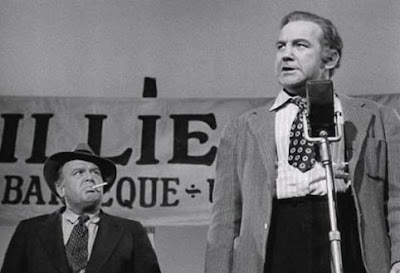Popular Notions of Populism
 From Fredric Jameson, Marxism and Form:
From Fredric Jameson, Marxism and Form: It should be pointed out, however, that this new modernism [Perry Anderson points to this passage as Jameson's first broaching of the postmodern] differs from the older, classical one of the turn of the century in at least one very essential way: that older modernism was in its essence profoundly antisocial, and reckoned with the instinctive hostility of the middle-class public of which it stood as a negation and a refusal. What characterizes the new modernism is however precisely that it is popular: maybe not in small mid-Western towns, but in the dominant world of fashion and the mass media.Anderson (and others) use the term 'populist' to refer to the orientation of postmodernism, whereas here Jameson is simply describing a predicate of its existence, or rather of its emergence. Yet I would like to build off the differentiation Jameson makes between being popular in "small mid-Western towns" and being popular "in the dominant world of fashion and the mass media." For now, I would like to think of "populist" as meaning simply that barriers to enjoyment are kept purposely low to facilitate the creation of popularity—of widespread, generally approbative consumption.
But it seems to me that the process by which populism succeeds and establishes popularity is conceived to operate in two very distinct modes, and that we associate them, more or less with discrete geographical spaces—the Midwest mentioned above, and Manhattan and its ambit, which can be as circumscribed as Manhattan and a few parts of Brooklyn or as extensive as "Blue State America," but which for brevity's sake, I'll just call Manhattan.
Popularity in Manhattan is primarily discursive and speculative—it's what gets mentioned and constantly adjusted by the process of mentioning. "Have you heard of…" "I just heard about…" etc. are applicable to the popularity of stocks, to neighborhoods, to books, to film, to art, to fashion. Populism consists in playing this discursive/speculative game consciously, adroitly, willingly.
Midwestern popularity isn't considered a product of discourse and it isn't considered quite so speculative—it's more like real estate, or I should say, like what we once thought about real estate. At any rate, what I think marks this form of popularity is that it is predicated not on discourse but on broadcast—we speak of market penetration or saturation, branding, things that aren't interactive, and aren't about generating "buzz." They're about forcing the product on someone, whether that product is a politician or a cigarette or a vulgarian comedy or James Patterson. Populism is Willie Stark, it's Dodge Ram trucks, it's Paul Blart, Mall Cop [G-d save us all].
 It could be argued that this second mode is not geographically limited in practice, that much more "branding" occurs in Manhattan, NY than it does in Manhattan, KS. I think this points more to a class differentiation in terms of how we conceive these operations being applied rather than an actual, straight-out geographic distribution, but the avoidance of class-conscious thinking rearranges this division in terms of comfortably separate geographies. This class into geography transmutation is evident if we consider the way these terms get used: market penetration isn't getting your product on the shelves of D'Agostino; it's getting it stocked on an end-of-aisle display in Meijers.
It could be argued that this second mode is not geographically limited in practice, that much more "branding" occurs in Manhattan, NY than it does in Manhattan, KS. I think this points more to a class differentiation in terms of how we conceive these operations being applied rather than an actual, straight-out geographic distribution, but the avoidance of class-conscious thinking rearranges this division in terms of comfortably separate geographies. This class into geography transmutation is evident if we consider the way these terms get used: market penetration isn't getting your product on the shelves of D'Agostino; it's getting it stocked on an end-of-aisle display in Meijers.What this dual modality means for postmodernism or late modernity or post-post-modernism or [insert your terminological flavor here] is, I think, quite interesting, particularly as new media has generated new ideas of popularity (i.e. virality) that are (or seem to be) incredibly non-spatialized. I'm honestly not as interested in carrying out this inquiry at the present as I am using this division to read theories of postmodernism, but it is (I hope) a provocative question.
Comments